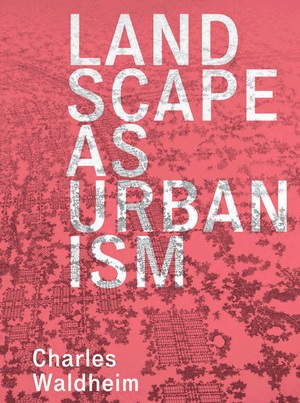Main author
Michael BrooksCharles Waldheim - Landscape as Urbanism: A General Theory
Charles Waldheim – ‘Landscape as Urbanism: A General Theory’
Published by Princeton University Press (2016)
In ‘Landscape as Urbanism’, author Charles Waldheim claims to have presented the first monographic account of a subject that has grown in prominence from a position of relative academic obscurity over the last decade-or-so. Waldheim , who is Professor and Chair of Landscape Architecture at Harvard University attempts to place landscape urbanism within the context of a broader set of historical, theoretical, and cultural conditions and proposes ‘a general theory for thinking the city through the medium of landscape.’
As an approximate definition, he suggests landscape urbanism is the theory of urban planning through the medium of landscape. It promotes the general idea that cities are best planned and organised, not through building and infrastructure design, but through the design of landscape.
In ‘Landscape as Urbanism’, Waldheim seeks nothing less than to establish the landscape architect as the urbanist of the age. Indeed, he presents a case early on, that ‘...the fundamental assumption that planning is the medium through which public policy and community participation are brokered may also be open for debate.’
Over the course of several chapters in this comprehensive book, Waldheim traces the history of landscape as a form of urbanism, from the Renaissance, through the dense industrial cities of the 19th century, to the early-20th century Fordist industrial economy, where landscape was reconceived as a medium of ecological planning. He states that in the contemporary post-Fordist industrial economy, ‘…landscape urbanism promises to clean the sites of the formerly industrial economy while integrating ecological function into the spatial and social order of the contemporary city.’
In so doing, Waldheim certainly makes a strong case for landscape urbanism, and, arguably, its inevitability. Perhaps such theories will become more prevalent and mainstream as people continue to densify in urban megacities over the next few decades.
The heavy text is scattered with generous illustrations that offer some interpretive clarity to what can become a vague and confusingly abstract subject. Mindful of this common criticism of the theory, with scant few real-life physical examples to draw from, the book includes works from around the world by designers such as Andrea Branzi, Frank Lloyd Wright, Michael Van Valkenburgh, and Ludwig Hilberseimer.
The thoroughness and depth of thought that Waldheim brings to this book and its ideas can feel rather like grappling with a piece of deconstructivist theory from the likes of Jacques Derrida or Jean Baudrillard. While this isn’t unnecessarily a bad thing, it can be more onerous and weighted down by academic verbiage than it needs to be, or ought to be for something purporting to be a ‘general theory’.
While those familiar with landscape urbanism will find a lot to appreciate in this intelligent and well-presented book, it may not succeed in enlightening a wider audience about this important but nuanced subject matter.
You can find out more and order the book here.
[edit] Find out more
[edit] Related articles on Designing Buildings Wiki:
- An Introduction to Passive House - review.
- BIM for Dummies - an interview.
- Biomimicry in Architecture - review.
- Brutalist London Map - review.
- ‘England’s Post-War Listed Buildings’.
- James Crawford - Fallen Glory.
- Landscape architect.
- Landscape urbanism.
- Last Futures: Nature, Technology and the End of Architecture.
- Living in the hyperreal post-modern city.
- London by Design - review.
- Manual of Section - review.
- Owen Hatherley interview.
- Owen Hatherley - Landscapes of Communism.
- Urban design.
Featured articles and news
Construction Skills Mission Board launch sector drive
Newly formed government and industry collaboration set strategy for recruiting an additional 100,000 construction workers a year.
New Architects Code comes into effect in September 2025
ARB Architects Code of Conduct and Practice available with ongoing consultation regarding guidance.
Welsh Skills Body (Medr) launches ambitious plan
The new skills body brings together funding and regulation of tertiary education and research for the devolved nation.
Paul Gandy FCIOB announced as next CIOB President
Former Tilbury Douglas CEO takes helm.
UK Infrastructure: A 10 Year Strategy. In brief with reactions
With the National Infrastructure and Service Transformation Authority (NISTA).
Ebenezer Howard: inventor of the garden city. Book review.
The Grenfell Tower fire, eight years on
A time to pause and reflect as Dubai tower block fire reported just before anniversary.
Airtightness Topic Guide BSRIA TG 27/2025
Explaining the basics of airtightness, what it is, why it's important, when it's required and how it's carried out.
Construction contract awards hit lowest point of 2025
Plummeting for second consecutive month, intensifying concerns for housing and infrastructure goals.
Understanding Mental Health in the Built Environment 2025
Examining the state of mental health in construction, shedding light on levels of stress, anxiety and depression.
The benefits of engaging with insulation manufacturers
When considering ground floor constructions.
Lighting Industry endorses Blueprint for Electrification
The Lighting Industry Association fully supports the ECA Blueprint as a timely, urgent call to action.
BSRIA Sentinel Clerk of Works Training Case Study
Strengthening expertise to enhance service delivery with integrated cutting-edge industry knowledge.
Impact report from the Supply Chain Sustainability School
Free sustainability skills, training and support delivered to thousands of UK companies to help cut carbon.
The Building Safety Forum at the Installershow 2025
With speakers confirmed for 24 June as part of Building Safety Week.
The UK’s largest air pollution campaign.
Future Homes Standard, now includes solar, but what else?
Will the new standard, due to in the Autumn, go far enough in terms of performance ?
BSRIA Briefing: Cleaner Air, Better tomorrow
A look back at issues relating to inside and outside air quality, discussed during the BSRIA briefing in 2023.
Restoring Abbotsford's hothouse
Bringing the writer Walter Scott's garden to life.
Reflections on the spending review with CIAT.




























Comments
A useful article.